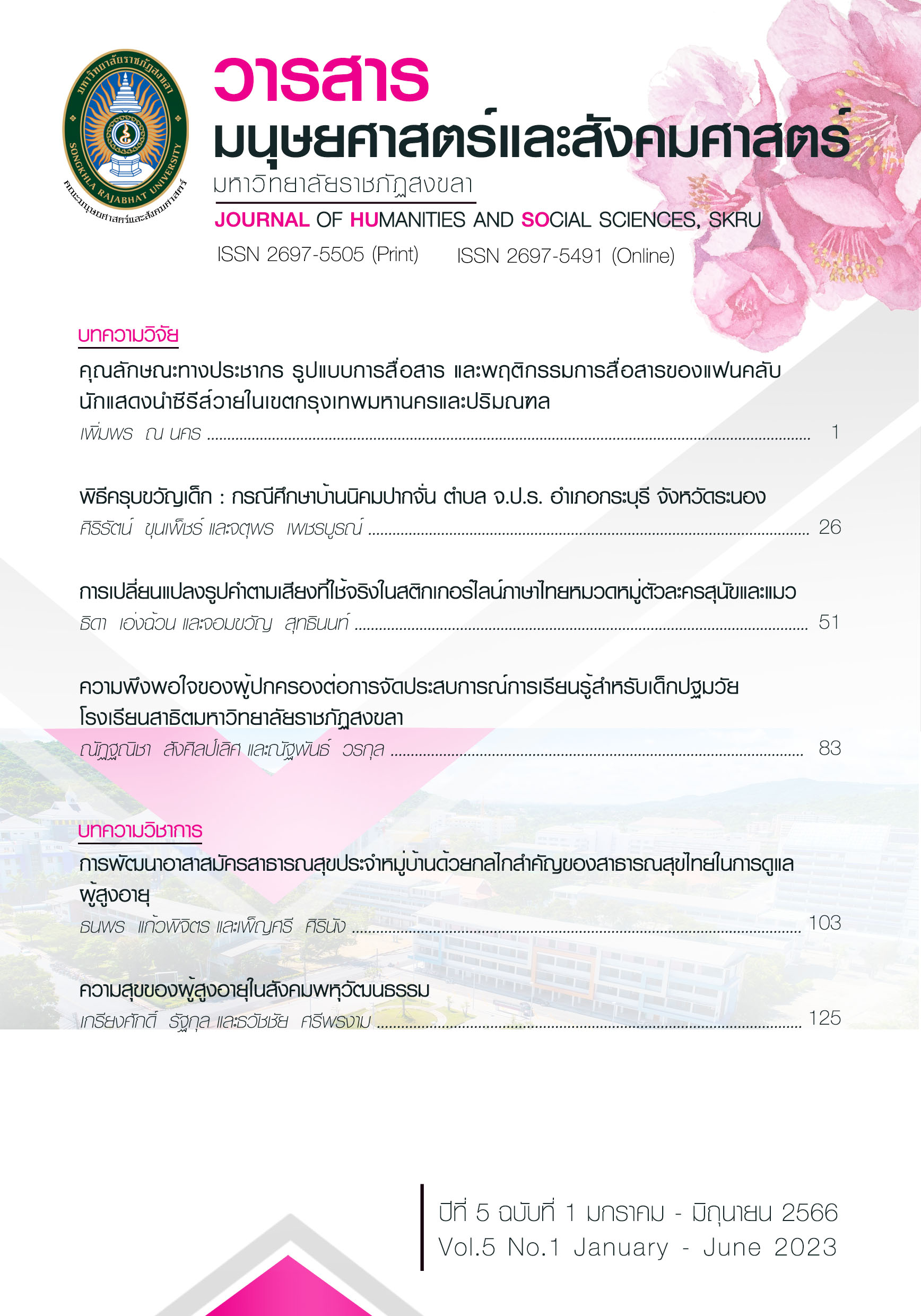CHILD BLESSING CEREMONY: A CASE STUDY AT THE BAN NIKOM PHAK CHAN IN JPR SUB-DISTRICT, KRA BURI DISTRICT, RANONG PROVINCE
Main Article Content
Abstract
The objectives of this study were 1) to investigate the child blessing ceremony in Ban Nikom Phak Chan in JPR sub-district, and 2) to analyze the child blessing ceremony in Ban Nikom Phak Chan in JPR sub-district, Kra Buri district, Ranong province. The study targeted a specific group and used tools such as interviews and observations to collect data from October to December 2022. The data was analyzed based on the concepts of performance communication and role. The study found that
The community of Ban Nikom Phak Chan has a traditional belief in "blessings" and the practice of blessing children from birth to 12 years old to prevent illness. The ceremony involves social performers such as the ritualists, the patient (child), and the parents, and is rooted in the belief in supernatural power and the ritual itself serves to create emotional stability. The ceremony is a center for family and kinship bonding and promotes social cohesion based on love, attachment, and belief, serving as a social asset for emotional well-being.
Downloads
Article Details

This work is licensed under a Creative Commons Attribution-NonCommercial-NoDerivatives 4.0 International License.
ลิขสิทธิ
References
กุศล หนูอินทร์. (2565, 15 พฤศจิกายน). การครุบขวัญให้ฐานะผู้เข้าร่วมพิธีกรรม [สัมภาษณ์].
ประเสริฐ รุนรา. (2563). สัญลักษณ์แม่ซื้อและลำบองราหู วัดพระเชตุพนวิมลมังคลาราม: ความสัมพันธ์กับโหราศาสตร์และแพทยศาสตร์. กรุงเทพฯ: คณะศิลปศาสตร์ มหาวิทยาลัยธรรมศาสตร์.
ปานวาด มากนวล. (2556). บทบาทและการสืบทอดคาถาและพิธีกรรมของหมอพื้นบ้านในการรักษาโรคที่บ้านหนองขาว จังหวัดกาญจนบุรี. (วิทยานิพนธ์อักษรศาสตรมหาบัณฑิต). สาขาภาษาไทย ภาควิชาภาษาไทย คณะอักษรศาสตร์. จุฬาลงกรณ์มหาวิทยาลัย, กรุงเทพฯ.
พจนานุกรมภาษาถิ่นใต้. (2550). ฉบับเฉลิมพระเกียรติพระบาทสมเด็จพระเจ้าอยู่หัวในวโรกาสเจริญพระชนมพรรษา 80 พรรษา. มหาวิทยาลัยราชภัฏนครศรีธรรมราช มูลนิธิร่วมพัฒนาภาคใต้และสถาบันทักษิณคดีศึกษา.
รุจินาถ อรรถสิษฐ. (2548). ขวัญ: ขวัญชีวิตของคนไทย. กรุงเทพฯ: กระทรวงสาธารณสุข.
วรรณี วิบูลย์สวัสดิ์ แอนเดอร์สัน. (2531). พื้นถิ่นพื้นฐาน: มิติใหม่ของคติชนวิทยาและวิถีชีวิตสามัญของ “พื้นบ้านพื้นเมือง”. กรุงเทพฯ: ศิลปวัฒนธรรม.
ศิราพร ณ ถลาง. (2557). ทฤษฎีคติชนวิทยา วิธีวิทยาในการวิเคราะห์ตำนาน - นิทานพื้นบ้าน. (ครั้งที่พิมพ์ 3). กรุงเทพฯ: โครงการเผยแพร่ผลงานทางวิชาการ คณะอักษรศาสตร์ จุฬาลงกรณ์มหาวิทยาลัย.
สวงค์ ขุนเพ็ชร์. (2565, 11 พฤศจิกายน). พิธีครุบขวัญเด็ก [สัมภาษณ์].
สุขเกษม ขุนทอง. (2561). โครงสร้างความสัมพันธ์ทางสังคมวิถีวัฒนธรรม “การเข้าทรงรักษาโรค” กลุ่มชาติพันธุ์เขมร อำเภออรัญประเทศ จังหวัดสระแก้ว. กำแพงเพชร: มหาวิทยาลัยราชภัฏกำแพงเพชร.
สุจิตต์ วงษ์เทศ. (2562). ขวัญเอ๋ย ขวัญมาจากไหน?. (ครั้งที่พิมพ์ 2). กรุงเทพฯ: สำนักพิมพ์นาตาแฮก.
เสฐียรโกเศศ. (2539). ประเพณีเนื่องในการเกิด. (ครั้งที่พิมพ์ 3). กรุงเทพฯ: สำนักพิมพ์ศยาม.
อิงอร จุลทรัพย์ และบุญเลิศ จันทระ. (2556). วัฒนธรรมการทำขวัญของคนสยามในมาเลเซีย. สงขลา: สถาบันทักษิณคดีศึกษา มหาวิทยาลัยทักษิณ.


